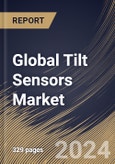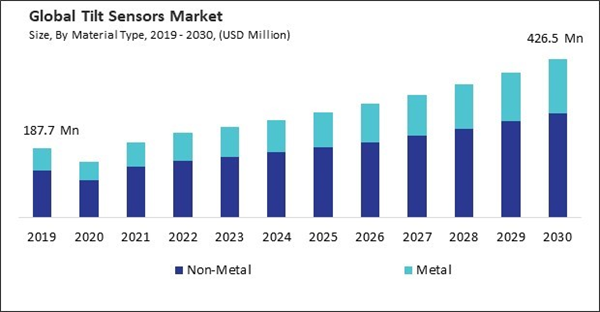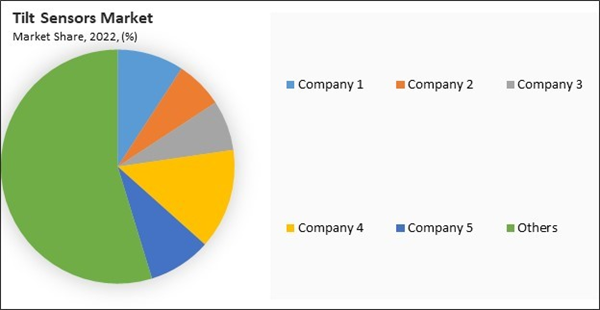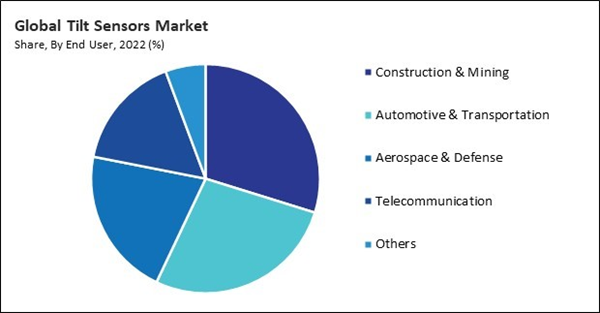The Global Tilt Sensors Market size is expected to reach $426.5 million by 2030, rising at a market growth of 8.3% CAGR during the forecast period. In the year 2022, the market attained a volume of 13,924.5 thousand units experiencing a growth of 10.8% (2019-2022).
MEMS technology enables the production of smaller, more compact, and cost-effective sensors compared to traditional mechanical or optical sensors. These miniaturized sensors are well-suited for integrating portable devices, consumer electronics, and space-constrained applications, driving demand in these markets. Consequently, the solid state (MEMS) segment would acquire nearly 75% of the total market share by 2030. Also, Russia would consume 568.0 thousand units of solid state (MEMS) sensors by 2030. Moreover, MEMS sensors are known for their low power consumption, making them ideal for battery-powered and energy-efficient devices such as smartphones, wearables, and IoT sensors.
These sensors are essential components of Advanced Driver-Assistance Systems (ADAS), which include features such as electronic stability control (ESC), rollover detection, and hill start assist. Additionally, these sensors are widely used in off-road and all-terrain vehicles (ATVs) for slope detection, rollover prevention, and terrain compensation applications. Thus, the rising acceptance of these sensors in the automotive sector propels the market’s growth. Additionally, Smart manufacturing involves integrating advanced automation and robotics systems to improve manufacturing processes’ efficiency, productivity, and flexibility. These sensors play a crucial role in these systems by enabling precise positioning, alignment, and control of machinery and robotic arms. Therefore, the growing adoption of smart manufacturing is driving the growth of the market.
However, high-precision sensors often have a premium price tag due to their advanced technology, superior accuracy, and precision engineering. Moreover, the high upfront cost of high-precision sensors can impact customers’ return on investment (ROI), especially if the additional accuracy and precision these sensors provide are not essential for their applications. Hence, the high cost of precise sensors hampers the market’s growth.
The leading players in the market are competing with diverse innovative offerings to remain competitive in the market. The above illustration shows the percentage of revenue shared by some of the leading companies in the market. The leading players of the market are adopting various strategies in order to cater demand coming from the different industries. The key developmental strategies in the market are Acquisitions, and Partnerships & Collaborations.
MEMS technology enables the production of smaller, more compact, and cost-effective sensors compared to traditional mechanical or optical sensors. These miniaturized sensors are well-suited for integrating portable devices, consumer electronics, and space-constrained applications, driving demand in these markets. Consequently, the solid state (MEMS) segment would acquire nearly 75% of the total market share by 2030. Also, Russia would consume 568.0 thousand units of solid state (MEMS) sensors by 2030. Moreover, MEMS sensors are known for their low power consumption, making them ideal for battery-powered and energy-efficient devices such as smartphones, wearables, and IoT sensors.
These sensors are essential components of Advanced Driver-Assistance Systems (ADAS), which include features such as electronic stability control (ESC), rollover detection, and hill start assist. Additionally, these sensors are widely used in off-road and all-terrain vehicles (ATVs) for slope detection, rollover prevention, and terrain compensation applications. Thus, the rising acceptance of these sensors in the automotive sector propels the market’s growth. Additionally, Smart manufacturing involves integrating advanced automation and robotics systems to improve manufacturing processes’ efficiency, productivity, and flexibility. These sensors play a crucial role in these systems by enabling precise positioning, alignment, and control of machinery and robotic arms. Therefore, the growing adoption of smart manufacturing is driving the growth of the market.
However, high-precision sensors often have a premium price tag due to their advanced technology, superior accuracy, and precision engineering. Moreover, the high upfront cost of high-precision sensors can impact customers’ return on investment (ROI), especially if the additional accuracy and precision these sensors provide are not essential for their applications. Hence, the high cost of precise sensors hampers the market’s growth.
The leading players in the market are competing with diverse innovative offerings to remain competitive in the market. The above illustration shows the percentage of revenue shared by some of the leading companies in the market. The leading players of the market are adopting various strategies in order to cater demand coming from the different industries. The key developmental strategies in the market are Acquisitions, and Partnerships & Collaborations.
By Technology Analysis
On the basis of technology, the market is segmented into solid state (MEMS), fluid-filled, and force balanced. In 2022, the force balanced segment attained a 10% revenue share in the market. Force balanced sensors can measure tilt angles over a wide range of motion, from a few to several degrees or even full 360-degree rotations. Construction, mining, and marine industries rely on force balanced sensors to provide accurate measurements across varying operating conditions and environments.By Application Analysis
Based on application, the market is categorized into construction & mining, automotive & transportation, aerospace & defense, telecommunication, and others. The automotive and transportation segment procured a 27% revenue share in the market in 2022. In terms of volume, the segment registered a consumption of 3,090.6 thousand units in 2022. These sensors play a crucial role in vehicle stability control systems designed to prevent rollover accidents and improve driving safety. These sensors detect changes in the vehicle’s tilt angle or inclination and provide real-time feedback to its stability control system, allowing it to adjust braking and steering forces to maintain stability and prevent loss of control in critical driving situations.By Material Type Analysis
Based on material type, the market is bifurcated into non-metal and metal. The metal segment attained a 30% revenue share in the market in 2022. In terms of volume, the metal segment attained a total consumption of 4535.2 thousand units in 2022. Metals exhibit superior mechanical properties such as high tensile strength, stiffness, and resistance to deformation compared to non-metal materials. Metal sensors can withstand high loads, vibrations, and shocks without compromising performance, ensuring reliable operation in demanding industrial environments. Therefore, superior mechanical properties are propelling the growth of the segment.By Regional Analysis
Region-wise, the market is analyzed across North America, Europe, Asia Pacific, and LAMEA. The Asia Pacific region witnessed a 40%revenue share in the market in 2022. Several countries in the Asia-Pacific region, including China, Australia, and India, have been investing heavily in the aerospace and defense sectors. These sensors are critical components in aircraft, spacecraft, and defense systems for navigation, attitude control, weapon targeting, and flight instrumentation. The expansion of the aerospace and defense sector is driving the demand for these sensors in the region.List of Key Companies Profiled
- The Fredericks Company
- Balluff GmbH
- Baumer Holding AG
- Sick AG
- IFM Electronics GmbH
- Jewell Instruments, LLC
- Meggitt PLC (Parker Hannifin Corporation)
- Murata Manufacturing Co., Ltd.
- TE Connectivity Ltd.
- Robert Bosch GmbH
Market Report Segmentation
By Material Type (Volume, Thousand Units, USD Million, 2019-2030)- Non-Metal
- Metal
- Solid State (MEMS)
- Fluid-Filled
- Force Balanced
- Construction & Mining
- Automotive & Transportation
- Aerospace & Defense
- Telecommunication
- Others
- North America
- US
- Canada
- Mexico
- Rest of North America
- Europe
- Germany
- UK
- France
- Russia
- Spain
- Italy
- Rest of Europe
- Asia Pacific
- China
- Japan
- India
- South Korea
- Australia
- Malaysia
- Rest of Asia Pacific
- LAMEA
- Brazil
- Argentina
- UAE
- Saudi Arabia
- South Africa
- Nigeria
- Rest of LAMEA
Table of Contents
Chapter 1. Market Scope & Methodology
Chapter 2. Market at a Glance
Chapter 3. Market Overview
Chapter 4. Competition Analysis - Global
Chapter 5. Global Tilt Sensors Market by Material Type
Chapter 6. Global Tilt Sensors Market by Technology
Chapter 7. Global Tilt Sensors Market by Application
Chapter 8. Global Tilt Sensors Market by Region
Chapter 9. Company Profiles
Companies Mentioned
- The Fredericks Company
- Balluff GmbH
- Baumer Holding AG
- Sick AG
- IFM Electronics GmbH
- Jewell Instruments, LLC
- Meggitt PLC (Parker Hannifin Corporation)
- Murata Manufacturing Co., Ltd.
- TE Connectivity Ltd.
- Robert Bosch GmbH
Methodology

LOADING...










